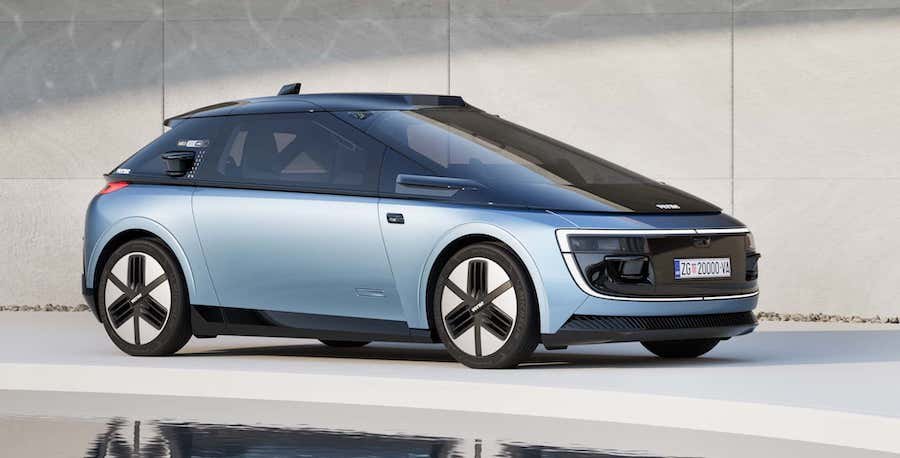Rimac, Maker Of Million-Dollar Hypercars, Just Launched A Robotaxi

It seems like automakers increasingly mistrust humans’ ability to drive around safely. The apparent solution to that? Develop vehicles without steering wheels and pedals, that will do the driving for you. The newest carmaker to jump on the self-driving bandwagon is Rimac. And it has already built its first robotaxi, the “Verne,” named after famous French novelist and poet Jules Verne.
It's a surprise twist, as Rimac started by building electric hypercars before forming a joint venture with Bugatti in 2021. Rimac owns a 55% controlling stake in the new parent company, Buggati-Rimac, with Porsche holding the remaining 45%. The latest offering from the JV is the new 1,800-hp Bugatti Tourbillion plug-in hybrid hypercar. The robotaxi, however, appears to be a product of Rimac Technology, a separate entity, 100% owned by the Rimac Group. Its first rollout is expected in 2026 in Zagreb, Croatia.
Rimac is calling its new project an “Urban Autonomous Mobility Ecosystem.” Rimac’s Chief Design Officer Adriano Mudri told Top Gear, that the Verne was “not a car, but a room on wheels.”
The Verne looks like a blend of a space capsule and a European hatchback. It’s a two-door two-seater EV, but the silhouette is nothing like what we’ve seen before. There’s a giant, very sharply raked windshield that stretches to the center of the car. “We wanted to make it still resemble a car so that people are not scared of it. It needs to be relatable and acceptable,” Mudri said.
Enabling self-driving is software and hardware from Israeli company Mobileye, which specializes in autonomous driving tech. The Verne robotaxi will use the Mobileye Drive platform, which includes a suite of advanced cameras, sensors and lidars. The long-range lidar—short for light detection and ranging—mounted on the roof can apparently scan the environment up to half a kilometer in the front. In addition to that, it's equipped with six short-range lidars and several cameras.
“Why a 2-seater? Because the data shows that nine out of 10 rides are used by one or two people,” Mudri said in a press release. “Therefore, we can satisfy most of all trips with a two-seater and create unmatched interior space in a compact-sized vehicle.”
Speaking of interior space, the legroom is reminiscent of the rear seats of a Mercedes-Benz S-Class. But the most striking element is the lack of a steering wheel and pedals. There’s no gear selector either, only a start-stop button to initiate the ride after you’re buckled in. There’s a giant 43-inch screen in the front, spanning the width of the dashboard, that can display the route or be used for on-the-go entertainment. You can also blast your favorite music from 17 speakers.
You call it via an app, similar to what Tesla is developing for its future robotaxi. Several features can be preconfigured before it even arrives, like cabin temperature, lighting, music and even selecting from a range of available scents. Thanks to the start-stop button, you can end your ride whenever you’d like and the vehicle will stop when it deems safe. “You’re not a prisoner in the car,” Mudri said.
Rimac has also thought of features users would require years down the line. Imagine your city is flooded with robotaxis that all look the same. When you order one, how would you identify your car? Of course, you’ll be able to see it approaching on the map from your smartphone screen, just like an Uber or Lyft, but there’s also a screen on the B-pillar that would display your name to improve visibility.
Rimac said there will be a dedicated piece of infrastructure called the “Mothership” in every city where the Verne operates. It’s where Verne robotaxis will be inspected, maintained, cleaned and charged daily. Rimac is also building its first production facility for the robotaxi in Zagreb, Croatia.
The Verne will roll out first in Croatia in 2026, followed by the U.K. and Germany. The automaker has signed agreements with 11 cities in the EU, the U.K. and the Middle East and talks are ongoing with 30 other cities.
It's worth noting that deploying autonomous vehicles has been a troublesome affair, especially here in the U.S., as we've seen with GM's Cruise and Google's Waymo division. Robotaxis have been involved in several dangerous road accidents and the technology remains far from proven.
Moreover, several questions remain unanswered here. We don't know the actual driving range of this robotaxi and how Rimac plans to comply with various regulations in different countries. All said, one thing is certain, the race to build the first ground-up driverless cars is heating up. This is just the beginning.
Related News
